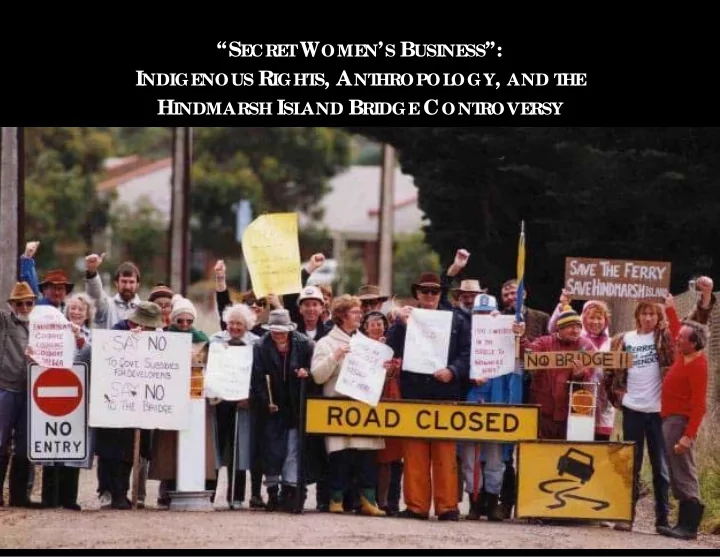

“S E W OME N ’ S B USINE SS ”: CRE T I NOUS R S , A NT OGY , AND T HE NDIGE IGHT HROPOL H INDMARSH I AND B RIDGE C ONT RSY SL ROVE 1
What makes something a secret? What is worth keeping secret? Should secrets be revealed? 2
T he Se tting for a Dispute Goolwa, South Australia, & Hindmarsh Island 3
4
the area “is crucial for the reproduction of the Ngarrindjeri people and the cosmos which supports their existence. The waters are a life force to the Ngarrindjeri women, whether past or present, and should anything cover these waters, then the strength there will be taken from the Ngarrindjeri women and they will become very ill”. Native Title Aboriginality, gender, secrecy, the judicial system, colonial history, economic development, cultural conflict—anthropology 5
Se c r e t Wome n’s Busine ss opposing Aboriginal views The Hindmarsh Island Royal Commission Prime Minister John Howard, the Hindmarsh Island Bridge Act (1997), bridge completed in March of 2001. Dr. Deane Fergie, anthropologist at the University of Adelaide 6
Confidential: to be read by women only Rod Lucas Neil Draper 7
T he Roots of Abor iginal Disse nt Aboriginal women who claimed that secret women’s business was a hoax ignorant of the origins and nature of Ngarrindjeri beliefs knowledge selectively distributed within a community “no point in reliving the past” Christian converts Anthr opologists at War ove r the T r uth male anthropologists ethics a feminist agenda? 8
Anthr opology and the Cultur e War s 2010, Government of South Australia: “secret women’s business” was real and authentic. Tom Trevorrow: “We may use the bridge to access our land and waters but culturally and morally we cannot come to terms with this bridge”. 9
Australia’s culture wars political correctness run amok “the willingness of white people to believe the Aboriginal women, marked the high-water mark of politically correct soft-headedness and sentimentality” (Simons, 2003) Ron Brunton and Roger Sandall Roger Sandall: The Culture Cult “designer tribalism” & “romantic primitivism” fantasies held by “spoiled white urbanites”. 10
the “invented traditions” approach Eric Hobsbawm, Richard Handler, etc. James Clifton’s The Invented Indian: Cultural Fictions and Government Policies 11
Se c r e t White Busine ss Margaret Simons: “Aboriginal culture is periodically attacked for being nepotistic, secretive and not accountable. I believe the story of the Hindmarsh Island affair makes it clear that the similarities between cultures are often more interesting than the differences….the story of the Hindmarsh Island bridge shows that, in both Aboriginal culture and in our own, information follows the lines of power, and secrets are the inevitable accompaniment to power.” 12
Re fe r e nc e s ABC. (2010). “Ngarrindjeri in symbolic walk across Hindmarsh Island bridge”. ABC News (Australia) , July 6. http://www.abc.net.au/news/2010-07-06/ngarrindjeri-in-symbolic-walk-across-hindmarsh/894792 Brunton, Ron. (1996). “The Hindmarsh Island Bridge: And the Credibility of Australian Anthropology”. Anthropology Today , 12(4), 2–7. Clifton, James A. (Ed.). (2017 [1990]) The Invented Indian: Cultural Fictions and Government Policies . New York: Routledge. Green Left. (1996). “Hindmarsh Island dispute: what was ‘fabricated’?” Green Left Weekly , January 31. https://www.greenleft.org.au/content/hindmarsh-island-dispute-what-was-fabricated Peace, Adrian. (2003). “Hindmarsh Island and the Politics of Anthropology”. Anthropology Today , 19(5), 1–2. Roger Sandall: Ideas and Argument http://www.rogersandall.com/ Rowse, Tim. (2000). “Review: Hindmarsh Revisited: Review Article—Reviewed Works: Ngarrindjeri Wurruwarrin: A World That Is, Was, and Will Be by Diane Bell; The Cost of Crossing Bridges by Dulcie Wilson”. Oceania , 70(3), 252–262. Sandall, Roger. (2001). The Culture Cult: Designer Tribalism and Other Essays . Boulder, CO: Westview Press. Simons, Margaret. (2003). “Hindmarsh: where lies the truth?”. The Age , May 9. 13
Tonkinson, Robert. (1997). “Anthropology and Aboriginal Tradition: The Hindmarsh Island Bridge Affair and the Politics of Interpretation”. Oceania , 68(1), 1–26. Weiner, James F. (1995). “Anthropologists, Historians and the Secret of Social Knowledge”. Anthropology Today , 11(5), 3–7. ————— . (1997). “‘Bad Aboriginal’ Anthropology: A Reply to Ron Brunton”. Anthropology Today , 13(4), 5–8. ————— . (1999). “Culture in a Sealed Envelope: The Concealment of Australian Aboriginal Heritage and Tradition in the Hindmarsh Island Bridge Affair”. The Journal of the Royal Anthropological Institute , 5(2), 193–210. ————— . (2004). “Australian Anthropology and Hindmarsh Island Bridge: A Response to Peace, AT19(5)”. Anthropology Today , 20(3), 24. 14
Recommend
More recommend